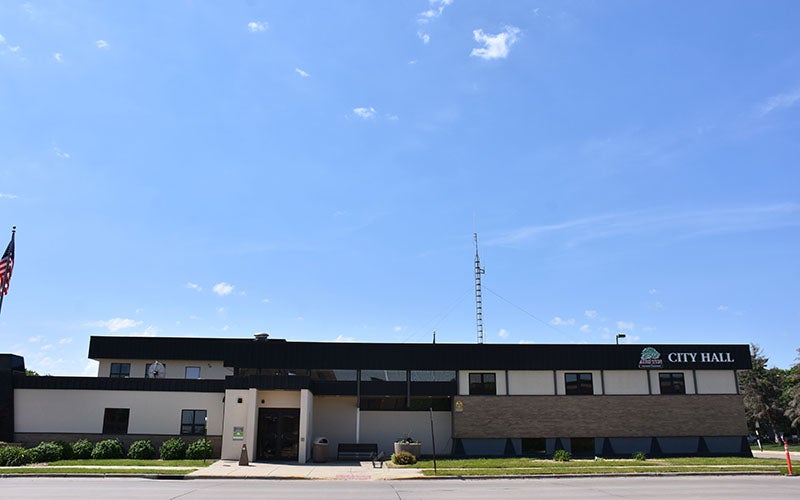Cracks start showing in road, bridge funding
Published 9:53 pm Sunday, March 23, 2014

Large chunks are missing from the sides of a bridge over Oakland Place Southeast. This bridge is one of the worst in Mower County and slated to be replaced this year. Eric Johnson/photodesk@austindailyherald.com
With several roads and bridges needing work, the question turns to the difficult task of paying for it
By Jason Schoonover and Trey Mewes
It’s easy for drivers in Mower County and Minnesota to see signs of age and wear on roads and bridges, but finding money for repairs is not so simple.
Just take Austin’s Oakland Place Southeast Bridge over Dobbins Creek and the East Side Lake dam. The bridge has been on Mower’s list of deficient bridges for several years, and clumps of cement have frayed from the edge of the bridge deck to expose rebar beneath.
The bridge, which averages 4,000 vehicles a day in traffic, is scheduled to be replaced this year for about $2.2 million. But work might be pushed back.
The problem is one gaining increased scrutiny across the state: There’s not enough money to meet the infrastructure needs for roads, bridges and overall transportation.
“Our roads and bridges aren’t going to get any better unless there’s funding,” Mower County Public Works Director Mike Hanson said. “We’re at a point right now where we’re going to start really seeing some serious deterioration of our road system.”
Road funding isn’t just a local issue — state and federal transportation dollars have stayed flat or dwindled over the years. Recent studies by the Center for Rural Policy and Development show Minnesota will face a $12 billion shortfall in road and bridge funding over the next two decades.
People are starting to notice.
The issue caused more than 200 businesses and organizations to form a lobbying coalition called Move MN dedicated to getting legislators to shift money back to transportation funds and create sustainable revenue sources.
“We are getting close to a crisis in funding,” said Darin Broton, Move MN campaign manager.
Mower County Commissioner Jerry Reinartz attended a seminar on roads at a recent Association of Minnesota Counties convention. He said it’s a top concerns for AMC, a non-partisan group that assists the state’s 87 counties.
“It’s huge throughout the state,” he said.
Dependent on upper levels
Counties rely heavily on funds from the state and — to a lesser degree — the federal level.
The Oakland Place bridge is dependent on the bonding bill currently being discussed in St. Paul. Gov. Mark Dayton proposed $30 million for bridge bonding this year, while the House proposed $31.7 million.
But several hands are trying to secure a stake in the pot.
“There’s a lot of competition for all the money that’s around,” Hanson said.
The House proposal promises $11.7 million for Hennepin County to restore the Franklin Avenue bridge, and House money will only be available if at least $16.5 million is committed from non-state sources.
Without state funding, the Oakland Place project will be deferred to next year. The issue could delay other county projects, too.
“We can’t obviously afford to spend $2 million in tax money because we don’t have it,” Hanson said of the money available in his budget.
The county receives state gas tax money for county state aid highways. But the per-gallon gas tax contributed to the funding shortage. The gas tax stayed largely unchanged for more than 20 years before it was raised in the late 2000s, and that span caused the value of the gas tax to drop because of inflation, according to Hanson.
“I think that was one of the big causes of the condition of our roads today, because we haven’t been able to fund problem maintenance and construction of the roadways,” Hanson said.
Federal funds make up a small portion of the local pie. In February, President Barack Obama visited St. Paul and called for $300 billion in highway funding, but Hanson called it “nothing special.”
Hanson described it as a plea to Congress to keep existing transportation funding. If approved, those funds will go toward projects already prioritized around the U.S. If not continued, several projects won’t move forward. There’s little new money, and Hanson said it’s not much when divided across 50 states and then counties.
“It’s really a drop in the bucket when you think about it,” he said.
Federal funds are highly competitive.
“We don’t see a lot of federal dollars unless we really go out and break our tails to get it, and if we do it’s not always available,” Hanson said, noting it includes a lot of paperwork.
New funding sources
Road and bridge work is only getting more expensive.
A typical two-lane, rural road costs about $800,000 per mile. When Hanson started in 1998, it cost $400,000 per mile. A typical urban road with curbs and gutters costs about $1.3 million per mile, according to Hanson.
The cost to repair roads and bridges has increased by about 70 percent overall since 2004, in part due to increasing oil, steel and aggregate prices and in part due to Minnesota’s chilly weather.
“Building and maintaining roads in Minnesota is a heck of a lot harder than Georgia or Texas or many parts of the country because of the climate,” Broton said.
That has Move MN seeking new funding sources.
The group is calling on legislators to close a loophole in the 2006 state constitutional amendment to give motor vehicle sales tax dollars to state transportation. Taxes on leased vehicles go to the state’s general fund, and while some of that money has been redirected to transportation projects, Broton said leased vehicle taxes create about $32 million in funding a year that Move MN believes should go back into transportation.
“We can take that $32 million out of the surplus and dedicate that money where it’s supposed to go,” Broton said. “It’s an easy solution that doesn’t cost taxpayers one new cent.”
The group also advocates a wholesale fuel tax on oil producers and refineries in the state. Broton said a wholesale tax would keep up with oil inflation and continue to provide revenue, as the gas tax revenue collected by the state has decreased over the past few years. Move MN estimates the cost of the tax wouldn’t significantly raise gas prices for consumers.
“We think it’ll be about a 10-cent increase at the pump, which is about equivalent to less than $2 a week per household,” Broton said.
Hanson envisions other potential changes in the future, like user fees based on mileage.
“There’s many, many things that need to be considered in fair and equitable transportation funding,” he said.
Move MN would also like to see more funding go toward bike and walk trail infrastructure throughout the state, as well as a 3/4 cent increase in the seven-county metro tax to fix more seven-county metro roadways.
Yet more funding is just a part of the issue for Move MN. The group is calling on the Minnesota Department of Transportation to be more transparent with its finances and projects.
“We have expectations that the Department of Transportation needs to be more upfront and transparent on how these projects are going, where the money is being spent and why things cost as much as they do,” Broton said.
A call for action
Local leaders don’t want the funding burden passed down, as Reinartz argued the state has taken measures to defer costs to counties.
Last year, the legislature approved a wheelage tax and a half-cent sales tax as options for counties to fund local road and bridge projects. Last June, the Mower board approved a $10 wheelage tax, which is paid when drivers renew licenses. The tax took effect Jan. 1 and was estimated to bring in $357,000 a year. Reinartz said Mower is not currently looking into the half-cent sales tax.
Reinartz called for more action and funding from the state and federal levels.
“We’re hoping we get some help from both the federal and the state government,” he said.
Mower County may be getting some help from the recently approved Pleasant Valley Wind Farm, which is slated to start construction in May and start producing energy by 2015. A year after the 88 turbines in Mower start producing energy, the county is slated to start receiving about $400,000 in additional annual revenue from the wind energy production tax credit. Reinartz said the county has discussed dedicating that money to road projects.
‘We care about them all’
Hanson expects road work to get underway in mid-May, as long as the weather cooperates.
With limited funding, officials need to prioritize projects, especially since Mower County Public Works oversees 369 bridges and about 405 miles of road.
“We care about all of them,” Hanson said.
However, that doesn’t mean there’s enough money to get to them all at once. About 10 years ago, Hanson found Mower County was about $2 million short on road funds a year — a number he expects is higher now.
“The public needs to know it’s not an issue that’s that simple to solve,” he said.
But officials will keep trying.
“I think we do the best we can with what we’ve got to work with,” Hanson said.



